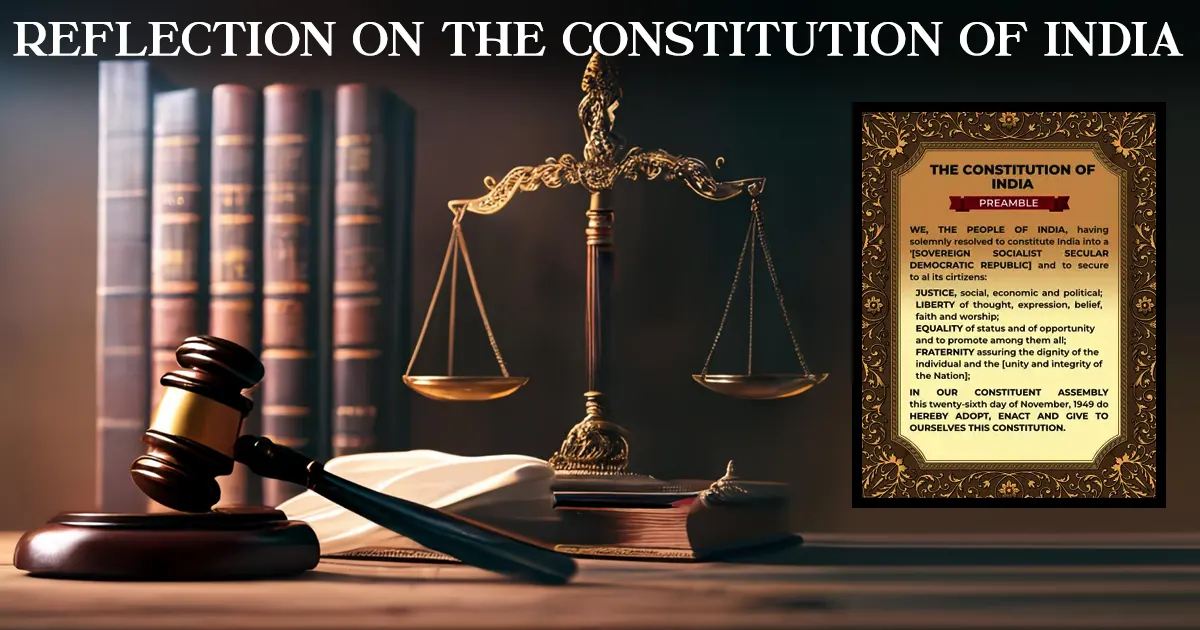
As India commemorates 75 years of its Constitution, it is an opportune moment to reflect on its significance, strengths, and the challenges posed by constitutional silences—gaps left either intentionally or inadvertently by the framers. These silences, while allowing adaptability, also create avenues for misuse, impacting democratic values and governance.
Significance of the Constitution
- Legal Framework:
The Constitution provides the foundation for governance, defining the powers, roles, and responsibilities of various institutions and ensuring a system of checks and balances. - Aspirational Document:
It represents the collective dreams, struggles, and aspirations of a diverse population, embodying the ideals of justice, liberty, equality, and fraternity. - Empowerment Tool:
It is a living document, evolving to address the changing needs of society, and serves as a framework for inclusivity, justice, and adaptability.
Challenges Posed by Constitutional Silences
- Pocket Vetoes (Article 200)
- Provision: Allows governors to grant, withhold, return, or reserve bills for the President without a specified timeline.
- Issue: Misuse by governors to indefinitely delay assent to bills, particularly in opposition-led states.
- Example:
The Tamil Nadu Prohibition of Online Gambling Bill faced significant delays in obtaining gubernatorial assent. - Impact: Undermines the federal structure by weakening the legislative authority of state governments.
- Ambiguity in Article 201
- Provision: No timeline is specified for the President to act on state bills reserved for consideration.
- Issue: Enables indefinite stalling of important state legislation.
- Impact: Creates legislative uncertainty and hampers state governance.
- Article 356 and the Term “Otherwise”
- Provision: Allows the imposition of President’s Rule based on vague recommendations or situations.
- Issue: Historically misused to dissolve opposition-led state governments, especially during the 1970s and 1980s.
- Impact: Undermines democracy and disrupts federal governance.
Broader Challenges
- Tool of Exclusion:
Marginalized groups, such as Dalits, women, and minorities, face systemic exclusion despite constitutional guarantees. - Representation Gaps:
Limited representation of women, minorities, and marginalized communities in both the framing and implementation of constitutional provisions. - Private Sphere Impact:
Extending constitutional principles like equality and non-discrimination to private domains remains a challenge, especially in areas like family law, caste-based discrimination, and economic inequities.
Judicial Interventions
- Purushothaman Nambudiri v. State of Kerala (1962):
The Supreme Court upheld the discretionary powers of governors but emphasized that they must act on the advice of the council of ministers. - Shamsher Singh v. State of Punjab (1974):
Reaffirmed the Cabinet system of governance, limiting the discretionary powers of governors and asserting that they must act in accordance with ministerial advice. - SC Interpretation of Article 200:
The Supreme Court interpreted the phrase “as soon as possible” to curtail indefinite delays by governors in granting assent to bills.
Benefits of Addressing Constitutional Silences
- Empowering Social Movements:
Constitutional provisions have been leveraged by marginalized groups for rights-based activism.- Example: Article 17 (Abolition of Untouchability) has been pivotal in the Dalit emancipation movement.
- Framework for Justice:
- Right to Information Act (RTI): Enhanced transparency and accountability in governance.
- Environmental Movements: Leveraged constitutional provisions for promoting sustainability and environmental justice.
- Global Recognition:
India’s Constitution is hailed for its adaptability and resilience in managing the complexities of a diverse society.
Way Forward
- Timelines for Decisions:
- Define reasonable timelines for the Governor and President to act on bills under Articles 200 and 201 to avoid undue delays.
- Clarity in Provisions:
- Redefine ambiguous terms like “otherwise” in Article 356 to prevent political misuse and ensure the imposition of President’s Rule is based on objective criteria.
- Institutional Transparency:
- Mandate regular reporting on pending bills and ensure judicial oversight to enhance accountability.
- Strengthen Federalism:
- Promote cooperative federalism through dialogue and engagement between the Union and state governments.
- Inclusive Policies:
- Address systemic inequities and promote grassroots participation to ensure that the Constitution serves as an instrument of empowerment for all.
- Educational Initiatives:
- Implement constitutional literacy programs to empower citizens with knowledge of their rights and responsibilities, fostering greater civic engagement.




